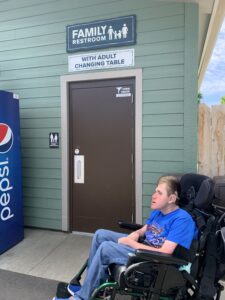
Code changes on adult changing stations
Code change E142-21 was approved as modified for the 2024 International Building Code to require adult changing stations in various occupancies
The International Codes (also known as the I-Codes), published by the International Code Council, continue to address new information, technologies or needs through its code change process. Code change E142-21 was approved as modified for the 2024 International Building Code (IBC) to require adult changing stations in the following locations:
- Assembly and mercantile occupancies that require an aggregate of six or more male and female water closets (e.g., multi-plex movie theaters, sports stadiums, airports and malls).
- Group B providing educational facilities that require an aggregate of 12 or more male and female water closets (e.g., college assembly halls and classroom buildings).
- Group E occupancies at assembly rooms that require an aggregate of six or more male and female water closets (e.g., high school basketball gymnasiums where the number of occupants in the seating would require six or more water closets — not the school itself).
- Highway rest stops and service plazas (e.g., the rest stops provided directly on the major highway — not the rest stops at exits).
The first item in the list might sound familiar, as this is where a family/assisted-use toilet room is also required. The intent is to provide adult changing stations in the same room as family/assisted-use toilet rooms, but not to require an additional toilet room. There is the same requirement to not require travel through a security checkpoint. In the past this was mainly for airports, but it could apply to other facilities that had certain areas with limited admittance, like a suites floor in a sporting venue. For those large facilities, the travel distance allowances to the adult changing facility of two stories and 2,000 feet were intended to require an adult changing facility in every other family/assisted-use toilet room. The International Plumbing Code allows for 500 feet of travel to separate sex toilet rooms, and then the IBC allows for another 500 feet and one story to get to the family/assisted-use toilet rooms from the separate sex toilet rooms.
The reasons given for this requirement were to address the needs of families with adult severely disabled children or elderly persons who are unable to use a toilet or may need to use catheters or adult diapers. Adult changing stations contain a changing table large enough to accommodate an adult-sized person that is located in a toilet room with a lavatory, water closet and trash disposal. Without such facilities, severely disabled people could suffer from isolation because they and their caregivers must return home to be changed. This lack of access has a profound impact not only on the person needing assistance but on their caregivers who are often their immediate family members. Normal activities outside the home such as shopping, entertainment and travel would otherwise be limited because of a lack of safe and sanitary places to change. These facilities will afford people with significant disabilities a measure of human dignity and protect their right to privacy.
 The ICC A117 committee — Consensus Committee on Accessible and Usable Buildings and Facilities or ICC (ASC A117) — established a task group to develop requirements for adult changing stations. This group met every two weeks from August 2020 to March 2021, looking at proposed rules from multiple states. This committee included architects, code officials, accessibility advocates, suppliers of adult changing tables and parents who needed these facilities. Code change E142-21 was developed by this group. They discussed that adult changing tables might be needed in other locations, like special education classrooms in schools, assisted living facilities and nursing homes. However, in these cases, the committee felt that where trained staff is the person offering assistance, instead of a family member, the configurations provided there should be decided by that facility. For example, in a school, it might be better to provide changing facilities in a screened area of the classroom or in a nurse’s office rather than in a toilet room that might be located away from where it was needed.
The ICC A117 committee — Consensus Committee on Accessible and Usable Buildings and Facilities or ICC (ASC A117) — established a task group to develop requirements for adult changing stations. This group met every two weeks from August 2020 to March 2021, looking at proposed rules from multiple states. This committee included architects, code officials, accessibility advocates, suppliers of adult changing tables and parents who needed these facilities. Code change E142-21 was developed by this group. They discussed that adult changing tables might be needed in other locations, like special education classrooms in schools, assisted living facilities and nursing homes. However, in these cases, the committee felt that where trained staff is the person offering assistance, instead of a family member, the configurations provided there should be decided by that facility. For example, in a school, it might be better to provide changing facilities in a screened area of the classroom or in a nurse’s office rather than in a toilet room that might be located away from where it was needed.
Now that this facility is scoped, what about the technical criteria? One of the issues with the proposed rules was that there were hardly any technical criteria provided. Investigating locations where adult changing was provided voluntarily, the task group found everything from adjustable electric tables and tables folding against the wall, to stretchers and fixed slabs. The committee discussed criteria for the table itself, including size, adjustability, clearances for transfer and access to the person on the table; and safety issues such as weight capacity and bars to stop someone from rolling off of the table. The task group also looked at requirements in the room, both for the person receiving care and the caregiver. This task group has proposed a change to the ICC A117.1 standard for the 2023 edition.
The ICC A117.1 committee will meet in 2022 to discuss this proposal along with many others that have been submitted. Anyone can participate in these meetings. At this point, the meetings are planned to be virtual. For meeting announcements and the posting of the proposals, watch the Standard Development Process page on the Code Council’s website.
The original purpose of the family/assisted-use toilet room was to allow for families with small children or adults that needed assistance to have a measure of privacy for assisted toileting. This went into the IBC in 2009. Adding the adult changing table in some of these toilet rooms makes these facilities even more inclusive.







